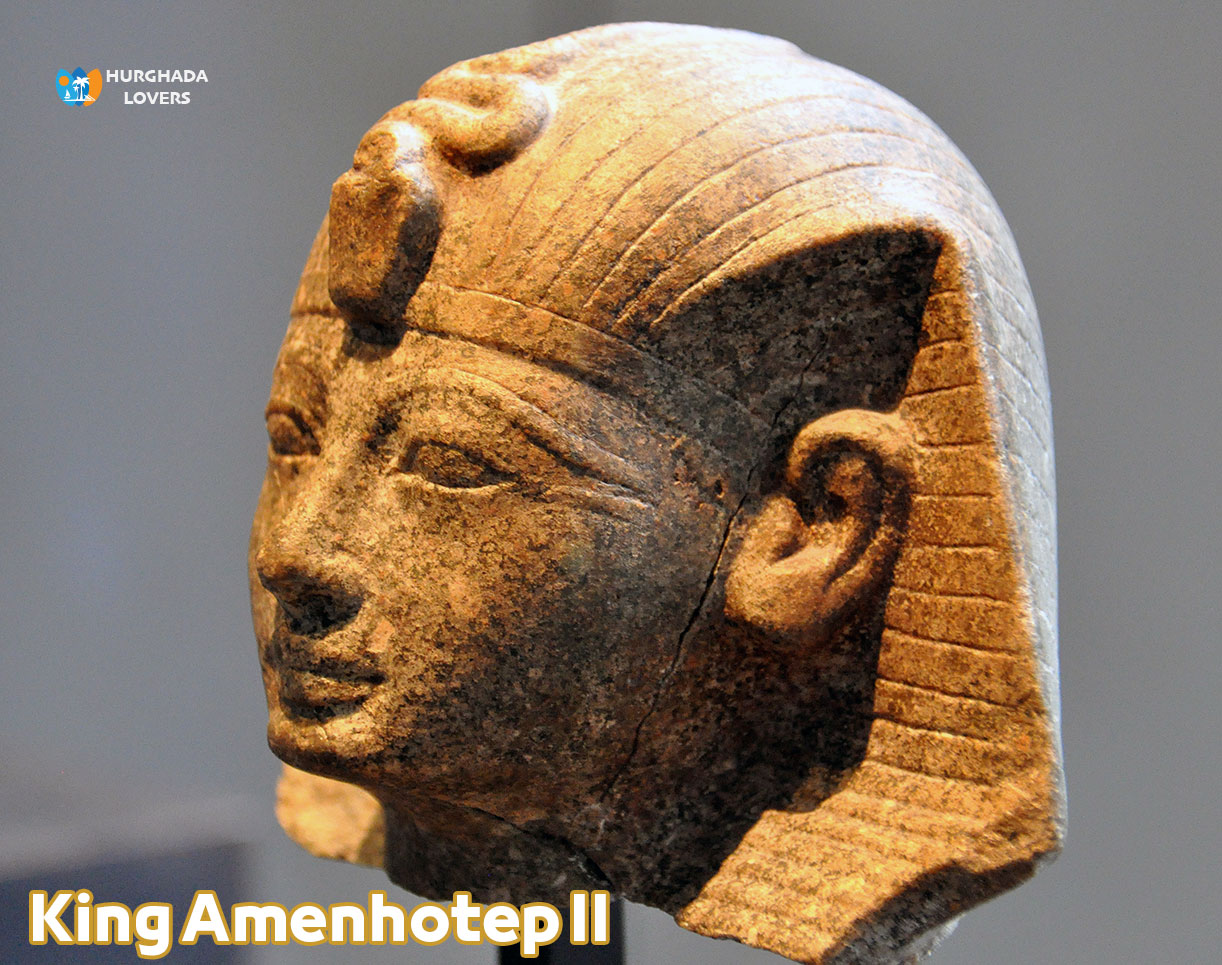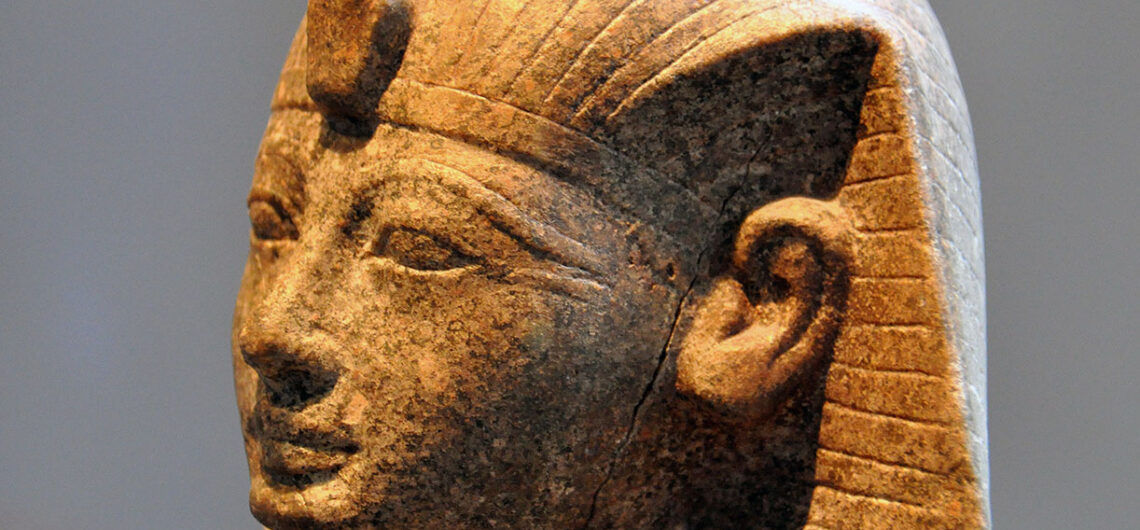King Amenhotep II – Egyptian Pharaohs kings – Eighteenth Dynasty of Egypt – The New Kingdom
The most important famous Egyptian kings of the ancient Pharaohs in the Eighteenth Egyptian Dynasty in the New Kingdom of Ancient Egypt | Secrets, biography and his Pharaonic Egyptian Antiquities, achievements in the ancient Egyptian civilization, tomb, Mummy, life and death of the king, the 18th Dynasty, and more about Ancient Egypt History.
King Amenhotep II
Ruling period: 1427–1401 BC
Duration of rule in Ancient Egyptian Government: 25 years.
Father: King Thutmose III “He has The Funerary Temple Of King Thutmose III in Deir El Bahari, Luxor and Tomb of King Thutmose III | KV34 in Valley of the Kings.
Mother: Queen Merytre-Hatshepsut “Tomb of Queen Merytre-Hatshepsut Ra | KV42″, the most famous Female Pharaohs “Pharaonic queen of Egypt”.
Wife: Queen Tiaa
Sons: King Thutmose IV
Archaeology:
- Stone statues indicate the development of the art of Sculpture in Ancient Egypt and Architecture in ancient Egypt, and more.
- Tomb of Amenhotep II No. 35 in the Valley of the Kings Tombs in Luxor (Thebes) in southern Egypt.
- Two funerary Mortuary Temples in Gurna.
- Celebration hall in the Karnak Temple complex.
- Funerary temple from the Egyptian Temples on Sai Island.
He is a member of the Eighteenth Dynasty, and he is the son of King Tuthmosis III. It is believed that he ruled Egypt from 1427 to 1401 BC, and his period of rule was shared with his father. Learn more information about the next king through the following:.
Historical facts about King Amenhotep II
- He is the son of King Thutmose III, the most famous pharaoh king of the New Kingdom era in ancient Egypt.
- He assumed the rule of Egypt immediately after his father’s death, attended the Coronation of the Pharaohs, and married Queen Tiaa.
- He is considered the seventh king of the Pharaohs in the Eighteenth Egyptian Pharaonic Dynasty.
- He had many skills in archery, equestrianism, horse riding, and playing Ancient Egyptian Sport and the games of the pharaohs.
- The entire period of his rule was peace with the neighbors and neighboring countries, as in the Geography of ancient Egypt.
- Carrying out many military campaigns against the country through the Military of ancient Egypt, which was occupied by Egypt during the period of the birth of King Tuthmosis III, to maintain the loyalty and obedience of the rulers to him..
Stories about the Pharaonic king:
- Texts and inscriptions were discovered drawn on the walls of the royal tomb of Amenhotep II in the Valley of the Kings in Luxor, by Commander Min, one of the supervisors of the upbringing and teaching of the Pharaonic prince in the arts of war and combat. It was translated and means “Stretch the bow to your ears, using all the strength in your arms, and steady the arrow, Prince Amenhotep.”“.
- A stone plaque was discovered inside the temple of King Amenhotep II, northeast of the Sphinx above the plateau of The Pyramids of Giza “Great Pyramid of Giza, Pyramid of Khafre, Pyramid of Menkaure” in Cairo.
- It tells us that when the age of the Pharaonic prince reached 18 years, King Tuthmosis III ordered that he be trained in horse riding and trained in martial arts in battles in the desert of the Giza Plateau next to The three pyramids, “the Great Pyramid, the Pyramid of Menkaure, the Pyramid of Khafre” and the Sphinx without fear for it. King Thutmose was proud of his son, the young prince, and was preparing him to rule the throne of Egypt..
- The pharaoh’s Mummy explained that he was a fan of sports, as his mummy was muscular.
- There is also evidence indicating that he was a fan of horse riding and practiced archery, and a granite plaque was found describing how skilled Amenhotep II was at throwing a bow..
- The painting says that King Amenhotep II was able to make his arrows hit a target made of copper, the most famous Ancient Egyptian Metallurgy, with a thickness of six centimeters, 14 times the thickness..
- The king had a private royal coach called “Min,” and his tomb is located in the cemeteries of the nobles in Luxor, “The Pharaonic Tombs from Thebes” and it bears number 109 among the Tombs of Sheikh Abdel Gorna, who later became the mayor of Thebes..
Period of rule
- During the reign of King Amenhotep II, he tried to preserve the Asian Empire, which was then owned by his father.
- The king’s attempts were very violent, and this appeared in his actions, which were to crush any type of rebellion and Revolutions in Ancient Egypt..
- In the third year of his reign, King Amenhotep II even sent a campaign to northern Syria, and it was the first war he launched in Asia.
- There is conflicting evidence that this war was during the period of joint rule between King Amenhotep II and his father.
- Inscriptions were found in Amda and Elephantine Island in Aswan, as well as in Armant, “the most famous Egypt Archaeological Sites.” The inscriptions indicate that Amenhotep II bragged about killing 7 princes of Thx..
- In the seventh year of rule, the king launched a campaign to Palestine, which began in the country of Retnu, and in which the king was able to subjugate the princes there..
- His campaigns did not end there, but he also reached the town of Shammas and was able to capture it in a short period, and then he was able to cross the Arnet River in order to seize more..
- King Amenhotep II then headed to a city called Kadesh and then Phoenicia. Until his ninth year, he sent another campaign to northern Palestine..
- The reason for the last campaign was to control a revolution, and its result was the taking of 80,000 prisoners.
- King Amenhotep II’s victories continued after that, as his army reached the Euphrates River in Iraq, until the princes of the Asian region rushed to him, declaring their loyalty to him..
- The victories ended with King Amenhotep II’s interest in the country’s foreign affairs, such as Trade in Ancient Egypt, after achieving an unparalleled victory in terms of war..
Acts of King Amenhotep II
- There are a group of temples as well as monuments dating back to King Amenhotep II, where he built a funerary temple for himself close to The Temple of Ramesseum area..
- The king also established a special hall for Pharaonic celebrations and holidays “Festivals in Ancient Egypt“, located in the temple of the God Amun, the most famous ancient Egyptian deities, in the Karnak region..
- Remains of a temple belonging to King Amenhotep II were also found on Sai Island. There is also a group of inscriptions in the front hall of the Kalabsha Temple..
- These inscriptions show the king making offerings to the Nubian god, in addition to a painting found in the quarries of Thebes.
- The painting features the king standing in front of two rows of 13 Ancient Egyptian gods and Goddesses.
Royal family tree
- King Amenhotep II gave birth to Tuthmosis IV, when he married his sister, Queen Ti-A“.
- It is believed that King Amenhotep IIhe have5 male sons besides Tuthmosis IV, who is the youngest of them.
- In addition to the number of girls, including Princess Yaarat, who became the wife of Tuthmosis IV and thus became queen.
Tomb of King Amenhotep II
- There is historical evidence indicating the date of the death of King Amenhotep II, which was in the year 1401. Some historians and Egyptologists “Egyptology” say that the year of death was in the year 1397 BC..
- The king was buried in tomb number 35 located in the Valley of the Kings.
- Decorated rocks were used to make the tomb, and a large group of deities were engraved, in addition to a complete copy of the Book of the Afterlife, “Book of Amduat” which is a funerary book..
- The tomb of King Amenhotep II was discovered in 1898 AD by archaeologist Victor Loret, the most famous Egyptologist..
- The Royal Cache of Deir el-Bahri were found containing 13 mummies of Egyptian kings, including his son, Thutmose IV, King Amenhotep III, and also Queen Tiye.
- Among the kings that were found were also King Siptah and king Merneptah from the Nineteenth Dynasty of Egypt, in addition to King Ramesses IV and King Ramses V, as well as King Ramses VI of the Twentieth Egyptian Dynasty (The Ramesside Period), in addition to King Setnakhte and King Seti II.
- The tomb of King Amenhotep II comes from a steeply sloping corridor that ends with a false well in order to mislead Ancient Egyptian Grave Robbers and also protect the tomb from the heavy rainy season..
- After the well, there is a side room in addition to a hall, and on the northern side there is a corridor leading to the burial hall, in which the Pharaonic sarcophagus “Ancient Egyptian Coffins” is located..
- The hall is raised on 6 columns and contains carvings of the gods of the dead, God Osiris and God Anubis, as well as God Hathor.
- The room’s ceiling is also blue, which resembles the sky, in addition to the presence of a group of stars, indicating the development of Astronomy in ancient Egypt.
Note: Facts and secrets of the history of the Pharaoh kings will be added soon…
Hurghada Excursions Lovers, Best Travel Agency in Hurghada to provide daily tours to visit the Tourist attractions of Luxor by Hurghada to Luxor Tours and Hurghada to Pyramids Trips. Book online when you come to Hurghada, El Gouna, Sahl Hashish, Makadi Bay, Soma Bay, Egypt.

